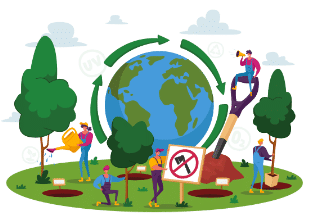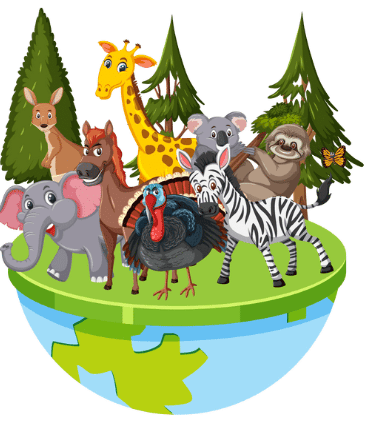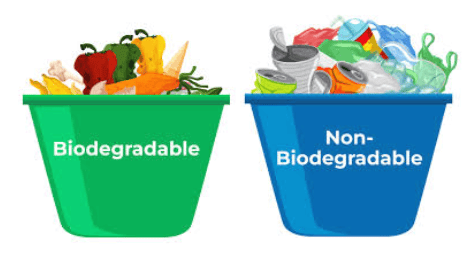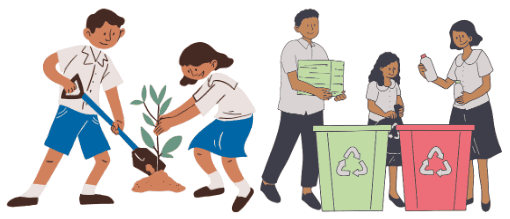Our Environment Chapter Notes | Science Olympiad Class 4 PDF Download
Introduction
The environment is everything around us—air, water, land, plants, animals, and even tiny microorganisms that we can't see. These parts work together like a team to create a place where we can live, breathe, eat, and grow.
Components of Our Environment
Think of the environment as a big puzzle with different pieces. Each piece is important for the whole puzzle to work. These pieces include:
Air: The air is the invisible gas around us. We breathe it in to get oxygen, which our body needs to work. Plants also use air to take in carbon dioxide and release oxygen.
Water: Water is found in rivers, lakes, oceans, and even in the air as clouds. All living things need water to survive. We drink water, and plants use it to grow.
Land: Land is where we build our homes, grow food, and live our lives. The soil in the land helps plants grow by giving them the nutrients they need.
Plants: Plants are important because they give us oxygen to breathe and food to eat. They also provide homes for many animals.
Animals: Animals are a part of our environment too. Some animals provide us with food, like chickens and cows, while others, like bees, help plants grow by spreading pollen.
Microorganisms: These are tiny living things that we can’t see without a microscope. Some microorganisms help break down dead plants and animals, returning nutrients to the soil.
All these components are connected and work together to create a balanced environment where life can thrive.
How Living Things Interact with the Environment
Living things, like humans, animals, and plants, don’t just live in the environment—they also interact with it. This means they affect the environment, and the environment affects them.
For example:
- Humans: We build houses, cut down trees, plant crops, and create pollution. Our actions can make the environment better or worse. If we take care of nature, it stays healthy. If we pollute it, we harm the air, water, and land that we depend on.
- Animals: Animals interact with their surroundings by looking for food, finding shelter, and raising their young. Some animals, like beavers, build dams that change the flow of rivers, which can create new habitats for other animals.
- Plants: Plants interact with the environment by growing and providing oxygen. They take in carbon dioxide from the air and use sunlight to make food through a process called photosynthesis.
This interaction shows that everything in the environment is connected, and what happens to one part can affect the others.
The Importance of Keeping the Environment Clean
Keeping the environment clean is very important because it directly affects our health and well-being. A clean environment means that the air we breathe, the water we drink, and the land we live on are free from harmful substances that can make us sick.
Why Cleanliness Matters:
- Health: If the environment is dirty, germs and insects can multiply and spread diseases. For example, stagnant (still) water can become a breeding ground for mosquitoes, which can spread diseases like malaria and dengue fever.
- Hygiene: Hygiene means keeping ourselves and our surroundings clean to prevent illness. For example, washing our hands, disposing of waste properly, and keeping our homes clean are all part of good hygiene.
- Sanitation: Sanitation involves taking steps to keep our surroundings clean and free from harmful substances. This includes proper waste disposal, treating sewage before it enters water bodies, and avoiding littering.
When we neglect cleanliness, we put ourselves and others at risk. Dirty environments can lead to outbreaks of diseases, which can be dangerous.
Proper Waste Disposal
One of the most important ways to keep the environment clean is by managing waste properly. Waste is anything we throw away because we don’t need it anymore, like food scraps, plastic bottles, and paper.
How to Handle Waste:
- Biodegradable Waste: This is waste that can break down naturally, like fruit peels, vegetable scraps, and paper. This type of waste can be composted, meaning it can be turned into soil that helps plants grow.
- Non-Biodegradable Waste: This is waste that does not break down easily, like plastic, glass, and metal. These materials need to be recycled or disposed of properly because if they are left in the environment, they can cause pollution.
Why Proper Disposal is Important:
- Preventing Pollution: When waste is not disposed of properly, it can pollute the land, air, and water. For example, throwing plastic into a river can harm fish and other animals that live there.
- Avoiding Disease: Waste that is left out in the open can attract flies, rats, and other pests that spread diseases. Proper disposal keeps these pests away and reduces the risk of disease.
The Three R’s: Reduce, Reuse, Recycle
To help manage waste and protect the environment, we can follow the three R’s:
Reduce: This means using less of something so that we create less waste. For example, turning off lights when you leave a room or not using plastic bags when you shop can help reduce waste.
Reuse: This means using something more than once before throwing it away. For example, you can reuse a plastic container to store food or a glass jar to hold pens and pencils.
Recycle: This means taking materials like paper, plastic, and glass and turning them into something new. For example, old newspapers can be recycled to make new paper, and plastic bottles can be recycled to make new products.
Why Recycling is Important?
- Saving Resources: Recycling helps save natural resources like trees, water, and minerals because it reduces the need to produce new materials from scratch.
- Saving Energy: Making new products from recycled materials uses less energy than making them from raw materials, which helps reduce pollution.
- Reducing Waste: Recycling reduces the amount of waste that goes to landfills, which helps keep our environment clean.

Steps to Maintain a Clean and Healthy Environment
To keep our environment clean and healthy, we should:
- Practice Good Hygiene: Wash your hands regularly, keep your home clean, and dispose of waste properly.
- Conserve Resources: Don’t waste water and electricity. Use them wisely so that we don’t run out of these important resources.
- Follow the Three R’s: Remember to reduce, reuse, and recycle to help minimize waste and protect the environment.
Key Points
- The environment is everything around us—air, water, land, plants, animals, and microorganisms.
- We need a clean environment for health.
- Proper waste disposal is crucial: biodegradable waste breaks down naturally, but non-biodegradable waste needs careful disposal.
- The three R’s—reduce, reuse, and recycle—help minimize waste.
- Reducing uses fewer resources, reusing gives items a second life, and recycling makes new products from old materials.
- By practicing good hygiene and conserving resources, we help keep the environment clean and healthy.
|
52 videos|70 docs|53 tests
|
















